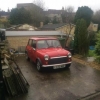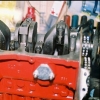
Thermostat Housing Bolt Sheared.

Best Answer WimpyMiniMan , 24 January 2016 - 12:35 AM
Update : Drilled out the hole and re-tapped and it's good as new! re-assembled thermostat housing with new thermostat and gasket, using studs and nuts. Then proceeded to fit new radiator, with new rad cap (15lbs) and new top and bottom hose. Filled to just outside 12mm of the filling orifice as recommended by the Haynes Manual. After a fairly involved rebuild went to start the car and had a flat battery! Recharged the battery and 5 hours later started the car and after some of the antifreeze i spilt burning off along with large amounts of wd40 i used whilst drilling and tapping, the engine appears to now be smoke free(-ish). Next thing i should think is the carburettor idle setting which needs adjusting, and a new windscreen and to fix the leak in the sunroof - once they're done the mini could even be mechanical problem free! - although rust is an underlying issue... always! Anyhow thank you ever so much for all the advice, and if you have any questions about the process feel free to ask! (NB: I thought i took photos, but my phone seems to have deleted them, and i dont intend on stripping it down again!)
Kind Regards
George
Go to the full post
#1

Posted 17 January 2016 - 08:54 AM
Cheers
George
#2

Posted 17 January 2016 - 09:38 AM
Without seeing the T'stat Housing I can't be 100% sure in saying this, however I'd suggest that a replacement housing maybe in order. Sure, you can probably drill the broken bolt out OK and refit it, but I'd guess that the reason this has occurred is advanced corrosion of the T'stat Housing. It may occur again quite quickly.
I always fit Bolts to the T'stat Housing these days, if or when corrosion starts, I've found I've got a MUCH better chance of getting it all apart without the need to break the T'stat Housing, which is actually harder to do than it sounds - without damaging the head or more so, the threaded holes for the bolts, they can break fairly easy. I also make a point of greasing the bolts (any grease will do, no need to use some expensive stuff) every single time they are out.
#3

Posted 17 January 2016 - 10:55 AM
Changing the thermostat two times a year does a few things. The housing does not get corroded in place. The studs get a bit of oil on then two times a year. And studs were used as then you were reducing the chance of damaging the head.
Aluminium oxide is quite easy to dissolve if you can get the agent down the bores. That is why I like nuts and studs over bolts.
#4

Posted 17 January 2016 - 11:25 AM
Thanks Again
George
#5

Posted 17 January 2016 - 11:32 AM
#6

Posted 17 January 2016 - 12:07 PM
#7

Posted 17 January 2016 - 12:45 PM
There is no thread in the housing ... ???
That's makes me feel better :) thought mine was stripped!
#8

Posted 17 January 2016 - 12:48 PM
Yes I can imagine stainless is better than standard but I think it's almost impossible to shear a stud since the tightening is on the nut not the stud - either are probably sound options I'm just thinking worst case scenario in terms of rust.Can see the case for nuts. I went for stainless bolts in the end though. Not that this is fool proof, but way better than standard bolts.
Thanks for all the comments.
Cheers
George
#9

Posted 17 January 2016 - 03:08 PM
Stainless is only better if there is no leakage of coolant around the bolt shank, head, and t-stat housing. You can actually set up a worse galvanic corrosion cell with stainless fasteners if you are not careful. I use stainless bolts covered top to bottom in anti-seize compound (I believe in the U.K. you refer to this as copper slip). I also apply gasket sealant to both sides of the t-stat housing gasket.
My suggestion for your existing t-stat housing is repeated gentle heating with a torch followed by quenching the stuck bolt with penetrating oil. As mentioned above, there are no threads in the housing so you want to work that penetrating oil down into the gap between the housing and bolt so you can break it loose and remove it.
So where did the bolt break? If it is stuck in the housing, were you able to unscrew it from the block before it bound up?
Edited by dklawson, 17 January 2016 - 03:08 PM.
#10

Posted 17 January 2016 - 03:16 PM
Can see the case for nuts. I went for stainless bolts in the end though. Not that this is fool proof, but way better than standard bolts.
Stainless steel bolt + cast iron head + a few heating and cooling cycles + coolant leakage/moisture = ![]()
#11

Posted 17 January 2016 - 04:15 PM
The bolt is stuck in the head not the housing just drilled through it but still can't seem to get it out.Stainless is only better if there is no leakage of coolant around the bolt shank, head, and t-stat housing. You can actually set up a worse galvanic corrosion cell with stainless fasteners if you are not careful. I use stainless bolts covered top to bottom in anti-seize compound (I believe in the U.K. you refer to this as copper slip). I also apply gasket sealant to both sides of the t-stat housing gasket.
My suggestion for your existing t-stat housing is repeated gentle heating with a torch followed by quenching the stuck bolt with penetrating oil. As mentioned above, there are no threads in the housing so you want to work that penetrating oil down into the gap between the housing and bolt so you can break it loose and remove it.
So where did the bolt break? If it is stuck in the housing, were you able to unscrew it from the block before it bound up?
Edited by WimpyMiniMan, 17 January 2016 - 04:16 PM.
#12

Posted 17 January 2016 - 04:34 PM
I've not found it to be a problem to be honest.
Can see the case for nuts. I went for stainless bolts in the end though. Not that this is fool proof, but way better than standard bolts.
Stainless steel bolt + cast iron head + a few heating and cooling cycles + coolant leakage/moisture =
#13

Posted 17 January 2016 - 05:45 PM
are you using an easy out/stud extractor?
if not then drill out to the tapping size then gently tap out the remaining threads, should come out like a spring, you should really clean the threads up with a tap as well.
#14

Posted 17 January 2016 - 07:18 PM
Problem with easi-outs are they expand the hole as you twist, and if they break... so hard, almost impossible to shift.
#15

Posted 17 January 2016 - 07:35 PM
The bolt is stuck in the head not the housing just drilled through it but still can't seem to get it out.
I'd suggest heating it, but I'd warn against using an extractor tool that may cause the broken stud to expand.
If there's something there to weld to, weld a bolt or nut to it and usually, that's enough heat to release it.
1 user(s) are reading this topic
0 members, 1 guests, 0 anonymous users




















